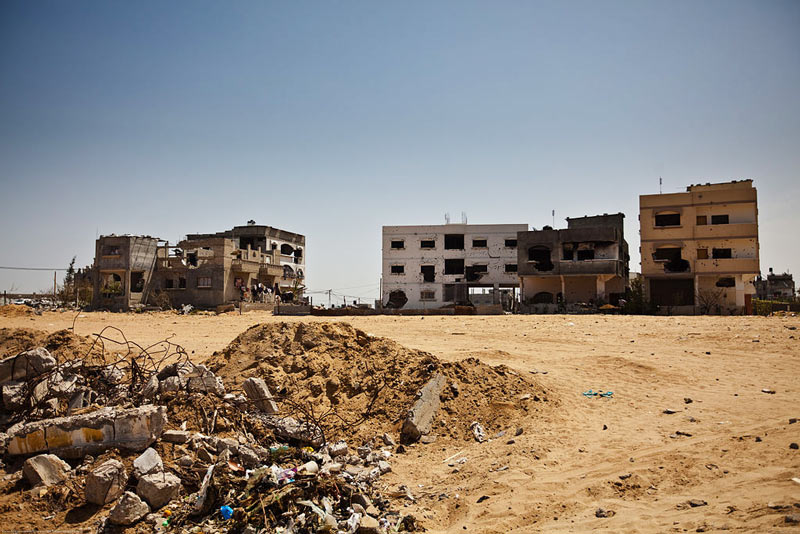The word ‘Gaza’ arouses passions and emotions whenever it is uttered. In this small territory of 360 square kilometres, wedged between Israel, Egypt and the Mediterranean Sea, more than 1.6 million souls live out their daily lives in what has been described as ‘the largest open air prison in the world’. Although thirty-eight years of physical occupation came to an end with the Israeli withdrawal of September 2005—and though the settlements that had appropriated a quarter of this limited space have now been dismantled—Gaza has remained cut off, first ‘sealed’ and then besieged, while the rivalries between the Palestinian factions have grown ever more embittered.
In June 2007 the supporters of Fatah and Hamas became embroiled in a civil war. Hamas, which emerged as the victor, subsequently established an Islamist administration in Gaza whose intransigence contrasted with the more moderate stance of the Palestinian Authority in the West Bank, where negotiation continued to be the preferred option in relations with the State of Israel. Israel responded with a military onslaught against the new administration in Gaza in the closing days of 2008. But this had little effect on Hamas’s resolve, despite the intensity of the violence—in those dark times, one inhabitant of Gaza in a thousand lost his or her life in the fighting: never had the territory undergone such destruction, much of which has yet to be repaired due to the subsequent Israeli blockade.

Considering the appalling reality of life in contemporary Gaza, a broader view of the current situation can only be taken from the perspective of history, with an attempt to set aside the disorientation, the horror and the hatred that the present situation has engendered. The ‘Gaza Strip’, as it is today, is not so much a geographical entity as the product of the tormented and tragic history of a territory where the majority of the population is made up of refugees who have already attempted to escape other torments, and other tragedies. Gaza’s borders have closed in on those who have fled there: the refugees born within the territory have been destined to remain confined within it, a fate they also share with all of those who have dreamed of leaving it. Neither Israel nor Egypt wanted the ‘Strip’ to exist: it is a territorial entity ‘by default’.
The intensity of the situation in Gaza enabled Palestinian nationalism to come into existence. It was here, a place without any particular symbolic significance, from which the Palestinian fedayin, and then in 1987 the ‘intifada’, emerged. The intifada, the so-called ‘revolt of the stones’, was the first step in a process that culminated in Israel’s recognition of the PLO (Palestine Liberation Organisation) and the latter’s recognition of the State of Israel. This was the first act in an ongoing peace process that has failed to result in peace. The participants in the process, the Palestinian Authority and the Israeli Labour Party, initially aimed to transform the territory of Gaza into the Hong Kong of the Middle East, a goal which appeared to be realistic enough at the time. Yet such an outcome now seems so distant as to be beyond reach.
It is therefore necessary to re-examine Gaza’s history in order to open a vista beyond today’s devastation and grief and to bring into view a new horizon for the future. This will not only benefit Gaza; as part of the world’s destiny is unfolding in symbolic terms within this small scrap of land, we all stand to gain from a better understanding of the territory’s long and complex history.
The act of writing a history of Gaza involves many difficulties and methodological problems, the first of which pertain to the local archives. In many cases parts of the archives have been destroyed in the course of successive conflicts, while other sections have been moved out of the territory by successive administrations and are today the object of wrangling between Fatah and Hamas, each of which claims to be the sole legitimate Palestinian Authority. In November 2010 I sought to overcome this deficiency with regard to local information by conducting a series of interviews, and I also succeeded in assembling a substantial repertoire of unpublished documents. The security constraints which prevailed in the territory, where certain zones remain off limits to research, presented a further problem. When the appropriate moment arrives, it would consequently be beneficial to go further into the various aspects of Gaza’s history that cannot be explored at present in order to enrich a Palestinian historiography that is still unduly centred on Jerusalem and the West Bank.
A further constraint that a historian encounters when researching contemporary Gaza concerns Hamas’s policy of promulgating an ‘official history’. Since taking power in 2007, the publications that have appeared in Gaza under Hamas’s auspices spuriously credit the Muslim Brotherhood with a continuous existence in a position of pre-eminence over the last seventy years, which suggests that the Brothers had always been in the vanguard and at the heart of the Palestinian nationalist struggle. Claims such as these naturally tend to withhold credit from the other Palestinian factions, and in particular from Fatah, which constitutes the current Palestinian Authority in Ramallah. The perspective of history provides the ability to reinterpret these often tenuous and biased accounts of Gaza’s history; and as Hamas’s intention is to reinforce its dominant position now and in the longer term, much is at stake.
Jean-Pierre Filiu is Professor of Middle East Studies at Sciences Po in Paris and the author of Gaza: A History.